Launch of a Website for “Erin's Challenge! I Can Speak Japanese.”
- Nihongo Kyoiku News
- This corner introduces the latest information on matters of high interest to overseas Japanese-language educators from among the Japanese-Language Education Programs conducted by the Japan Foundation.
Miyuki Akazawa,
Lecturer, Japanese Language Institute, Urawa
A website for “Erin's Challenge! I Can Speak Japanese,” a series of Japanese-language DVD teaching materials featuring up-and-coming actors and stars of TV dramas and commercials such as Ellie Toyota and Kana Kurashina, was launched on March 31, 2010. The website is designed to provide people around the world interested in Japan and Japanese language with opportunities to learn about contemporary Japan and its culture, and to study Japanese language in a fun and easy way.
Here we would like to introduce the features of this website and its recommended contents.
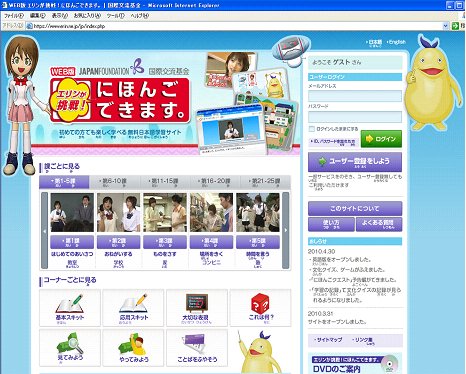
Features
The website contains Japanese-language teaching materials in which language study and cultural understanding are closely related(1). The objective of Japanese-language learning through this website is not simply to increase learners' command of the Japanese language, but to enhance the scope of things they can do in Japanese. Furthermore, the website aims to promote understanding of a different culture and multiculturalism through Japanese-language learning via numerous visual and audio materials.
- (1) For details, refer to Nihongo Kyoiku Tsushin No. 59, Nihongo Kyoiku News “Concept behind the Teaching Materials “Erin's Challenge! I Can Speak Japanese'”
(http://www.jpf.go.jp/j/project/japanese/teach/tsushin/bn/dw_pdfs/nk59_01-03.pdf (PDF:2.45MB))
Organization and contents
This website consists of 25 lessons. Each lesson is composed of seven sections: “Basic skit,” “Advanced skit,” “Key phrases,” “Develop vocabulary,” “What's this?,” “Let's see,” and “Let's try.” These sections serve the following purposes: to support Japanese-language learning and cultural understanding, and to connect Japanese-language learning with cultural understanding (Figure 1 ).
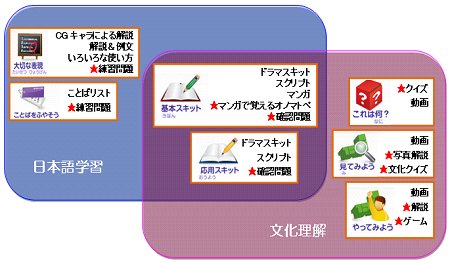
Figure 1 Organization of the website for “Erin's Challenge! I Can Speak Japanese.”
(The ★ mark indicates original content available only on the website.)
Sections that connect Japanese-language learning with cultural understanding: “Basic skit” and “Advanced skit”
The “Basic skit” and “Advanced skit” sections are structured in a drama format and expose Japanese-language learners to contemporary Japanese culture and lifestyle, while enhancing their command of natural Japanese language as it is actually used.
In order to make the subtitles and scripts of the skits accessible and user-friendly to learners of various levels, the website offers an option to display them in three types of writing systems—Chinese characters mixed with Japanese phonetic characters, Japanese phonetic characters only, and Roman letters—and in English. The page, in which the “Basic skit” is displayed in a manga format, features various convenient functions (Figure 2). For instance, the script in the word balloons can be switched between the four types of display. Also, by clicking on each word balloon, learners can listen to an audio recording of the line.
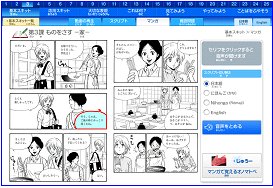
Figure 2 Basic skit > Manga
The new content created exclusively for the website includes the pages “Learn onomatopoeia with manga” and “Review questions” on the skit's content. In the “Learn onomatopoeia with manga” page, learners can peruse explanations and examples of the use of various onomatopoeic expressions, such as gatagata, kyorokyoro, etc., that appear in the manga, and view movies of the actual sounds or actions expressed through the onomatopoeic expressions (Figure 3). The “Review questions” pages contain a total of 250 questions on the skit's content.
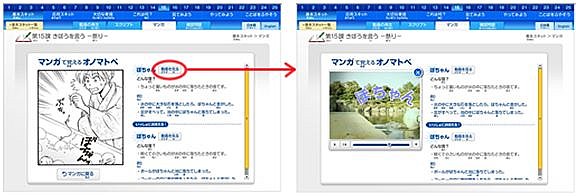
Figure 3 Basic skit > Learn onomatopoeia with manga
Sections that support Japanese-language learning: “Key phrases” and “Develop vocabulary”
The “Key phrases” section contains grammar explanation animated films that feature CG characters (Figure 4) and a page “Explanation & example sentences,” which provide learners with an opportunity to enhance their command of Japanese-language grammar and syntax rules and their use. Since the purpose of Japanese-language learning via this website is not to memorize and exactly repeat Japanese-language grammar and syntax structures, but to increase the number of things learners can do in Japanese, the “Key phrases” section contains a page “Key phrases in different situations,” which features movies that demonstrate the use in real everyday situations of the grammar and syntax structures presented in the skits. The “Exercise” page (Figure 5), which contains audio materials, illustrations and photos, is particularly useful for acquiring a lasting command of the newly-learned grammar and syntax structures. The total of 1,519 questions in the 25 lessons are original content developed exclusively for the website.
The “Develop vocabulary” section provides learners who wish to expand their vocabulary with rich content composed of illustrations and audio materials that help them learn new words for situations and topics related to each lesson.
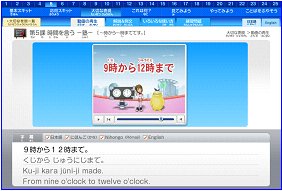
Figure 4 Key phrases > Play movie
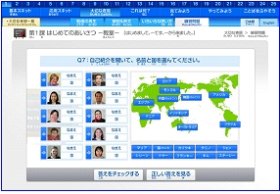
Figure 5 Key phrases > Exercise
Sections that support cultural understanding: “What's this?,” “Let's see,” and “Let's try”
The “What's this?” section teaches, through quizzes and movies with explanations of actual applications, about things that Japanese take for granted and use in their everyday lives, but that are strange and difficult-to-understand for foreigners.
The “Let's see” section features movies and a total of 633 photos accompanied by explanations. Japanese-language learners can use them to study about contemporary Japan based on the situations and topics discussed in the 25 lessons. The “Culture quiz” is original content developed exclusively for the website. It is a must-see for those who wish to enhance their understanding of Japanese culture. We recommend learners to test their knowledge in the quizzes on 25 topics. Twenty consecutive correct answers will bring them a “black belt” and 30 consecutive correct answers will promote them to “grand masters” (Figure 6).
In the “Let's try” section, Japanese-language learners can view movies featuring foreigners who experience various forms of traditional Japanese culture, such as calligraphy, ikebana (flower arrangement), and abacus, and young people's modern cultural phenomena, such as cell phone e-mail and photo stickers. This section contains game pages, which were newly developed for the website. The “Virtual Flower Arrangement Game,” “Erin's Print Studio Game,” “Enoden Sugoroku Game” (Figure 7), and a variety of other games provide learners with rich opportunities to experience Japanese culture and lifestyle.
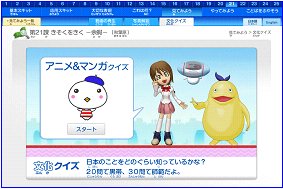
Figure 6 Let's see > Culture quiz
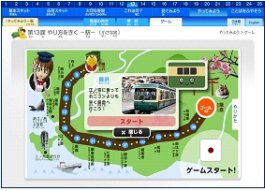
Figure 7 Let's try > Games
Useful and fun functions for registered users: “Record of your learning,” “Avatar,” “Nihongo Quest” game
Learners do not need to register in order to view the content of this website. However, there are some helpful and fun functions of the website that are available only to registered users.
The “Record of your learning” is a function that automatically keeps a record of when and what you learn. Once you log in, each page that you access to study is registered in the “Record of your learning,” so you can independently proceed with your Japanese-language learning while checking the record of viewed pages.
“Avatar” is a function that allows users to create their own images that can be used only in this website (Figure 8). We invite learners to make their look-alike avatars by choosing from a rich variety of facial features, hair styles, etc. At the time of registration, the range of available outfits and other items from which users can choose is limited, but the more users learn, the more points they get. Using these points, users can increase their avatar's items.
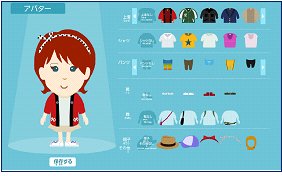
Figure 8 “Avatar”
The “Nihongo Quest” game is a virtual town, where users can have conversations with people using the Japanese language they learn through this site (Figure 9). The more learners study in the site and increase the number of things they can do in Japanese, the better they can communicate with the people they meet in the virtual town. Also, as the number of lessons they complete grows, users gain access to more places to visit, such as “Fashion Town” and “Hot Spring Spa.”
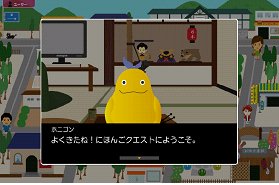
Figure 9 Game “Nihongo Quest”
Utilization status of the website for “Erin's Challenge! I Can Speak Japanese.” after its launch
In the approximately two and half month period from the launch of the website for “Erin's Challenge! I Can Speak Japanese.” on March 31 to June 15, 2010, it was visited by 39,907 users(2) from 140 countries and regions. In the ranking of countries and regions by number of sessions(3) Japan comes first (16.7%), followed by China (13.5%), the United States (9.6%), the Republic of Korea (6.9%), and Australia (6.4%) (Figure 10). According to the "2006 Overseas Japanese-Language Education Organization Survey" conducted by the Japan Foundation, overseas Japanese-language education is provided in 133 countries and regions around the world, so the above data demonstrates that in the relatively short span of just one month, people from a wide range of countries and regions have accessed the site. The number of sessions to the site was 81,451, and the number of page views(4) - 679,168.
- (2)This is the number of unique users. The term “unique user” refers to users who visit a certain website more than once. Regardless of the number of times a user visits that website, that user is counted as a single “unique user.”
- (3)The term “session” refers to the information exchange from the moment a user accesses a certain site to the moment the user moves to a different site. Even if the user browses multiple pages within the same site, the period of time spent on all pages is still counted as a single session.
- (4)The term “page view” refers to a request to load a single page of an Internet site. When a user visits a site and views multiple pages, each instance of the user loading a page is counted as a single page view.
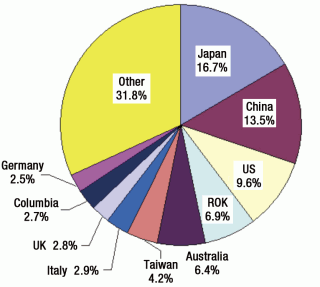
Figure 10 Ratio of sessions by country/region
Future perspectives
At the moment, the website for “Erin's Challenge! I Can Speak Japanese.” is available only in Japanese and English, but we are considering releasing versions of the website in other languages in the future. Going forward, we will continue to develop this website in order to make it more user-friendly and enjoyable for all people around the world who are interested in Japan and Japanese language, so please visit the various pages of the website and send us your impressions and opinions.
- What We Do Top
- Arts and Cultural Exchange [Culture]
- Japanese-Language Education Overseas [Language]
- Japanese-Language Education Overseas [Language] Top
- Learn Japanese-language
- Teach Japanese-language
- Take Japanese-Language Test
- Know about Japanese-language education abroad
- The Japanese-Language Institute, Urawa
- The Japanese-Language Institute, Kansai
- Japanese-Language Programs for Foreign Specified Skilled Worker Candidates
- Japanese Language Education for Japanese Children Resident Overseas and for the Descendants of Migrants
- Archives
- Japanese Studies and Global Partnerships [Dialogue]
- JF digital collection
- Other Programs / Programs to Commemorate Exchange Year
- Awards and Prizes
- Publications
